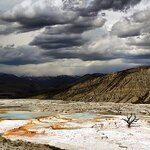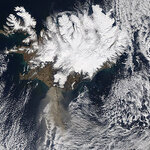Geology

Does anybody remember that film, Mission to Mars? Its a good one. Basically, this band of astronauts tootle off to Mars to find their buddy, against all odds find him and, moreover, find that he seems to be doing just fine by growing tomatoes in a make-shift greenhouse. They then all decide to pop out to see the Face of Mars after he recounts having heard a weird sound near there.
(By the way, there's a bit of a spoiler alert coming, but it is 10 or so years after the film came out, so it's fair game!)
So, moving on, they go to the face and, lo and behold, the face opens, and they step…

Sometimes good things result from bad things. When scientists drilling near an Icelandic volcano hit magma, they had to abandon their experiments on geothermal energy but it turns out they may have discovered an alternative source of geothermal power.
When tested, the magma well produced dry steam at 750 degrees Fahrenheit , enough to generate up to 25 megawatts of electricity, which could power 25,000 to 30,000 homes. Fine, fine, but what does that mean? Only 5 to 8 megawatts are produced by a typical geothermal well, and Iceland already gets about one-third of its…

Usually, I don't think it is worth pointing out everything the media gets wrong. I don't think it is particularly constructive concentrating on what's wrong, better to simply try and write well about science myself. However, there occasionally appears such an impressive collection of scientific myths that something really needs to be said about them. This video from CNN is one of them.
The background to the video is that a study found that the ground is swelling in Yellowstone, a fact the authors of the study attributed to fresh magma intrusion at depth. While this…

Erik Klemetti (of the Eruptions Blog) posted about this paper (An extraordinary episode of Yellowstone caldera uplift, 2004–2010, from GPS and InSAR observations) that has been causing a bit of a stir in the media, and I recommend you read his post on what they got wrong (a lot in the case of the two articles I've linked to). The paper itself is quite interesting (especially to me as my research is on a similar caldera system), so I thought I'd write a little about it here.
Upper Terraces of Mammoth Hot Springs, Yellowstone. By Mila Zinkova (Own work) CC-BY-SA-3.0, via Wikimedia Commons…
About 250 million years about 70 percent of life on land was wiped out. A new study says it has evidence to support massive volcanic eruptions that had broad impact on the global oceans and contributed to the extinction.
Researchers at the University of Calgary believe they have discovered evidence for the hypothesis that volcanic eruptions burnt significant volumes of coal, producing ash clouds that had broad impact and was a direct factor in the late Permian extinction.
Unlike the end of dinosaurs 65 million years ago, where there is belief that the impact of a meteorite was at least…

As Where on Google Earth #252 was somewhere I know well, having studied a course that was almost entirely dedicated to the tectonics of the region (which included a fieldtrip), I'm quite glad I managed to work it out. The fan delta in the centre of the coastline shown is just one of many in the region, formed due to the interaction of the faults uplifting the mountains to the south and the sea. There are also some spectacular outcrops of faults planes exposed in quarries, where the fault surface has been preserved due to its burial. Perhaps the most spectacular example of…

The eruption of Eyjafjallajökull (here is Wikipedia's handy pronunciation file) last summer was widely covered in the media, generating some stunning images (and perhaps the most beautiful video of the year). From a scientific point of view there was also lots to get excited by. Eyjafjallajökull, like most Icelandic volcanoes, is monitored by the Icelandic Meteorological Office. This meant that there were seismometers and GPS stations ready to capture the eruption, along with precursor activity. The analysis of this data has begun to trickle out, most notably in this…
It may seem intuitive that the Moon might have a core, just as Earth does, but science doesn't work on intuition. Absent drilling or inference, it has been hypothesized that Luna has a core but now researchers are closer to an answer, thanks to old Apollo missions.
A group of researchers analyzed older seismic data using new techniques and now say the Moon possesses an iron-rich core with a solid inner ball nearly 150 miles in radius, and a 55-mile thick outer fluid shell.
"The Moon's deepest interior, especially whether or not it has a core, has been a blind spot for…

Happy New Year, and welcome to the first "Where on Google Earth" (WoGE) of 2011. I was shocked to find out that my guess at WoGE #245 was correct, (Plymouth, Montserrat being the most post-apocalyptic looking place I could think of) so it is with great pleasure that I present WoGE #246.
For those of you new to this, the rules are simple. The winner is the first person to correctly guess where the picture below is from, and to post a comment with the location (name or latitude/longitude) and a brief description of the geology of the region. The prize? The chance to host…

Mountains are the epitome of durability but some new data shows how ancient precipitation was really the driving force behind the mountains of the Farallon Plate between 65 and 28 million years ago.
50 million years ago, mountains began rising in southern British Columbia and over the next 22 million years, mountains began rising down western North America as far south as Mexico and as far east as Nebraska, says the new research.
This is in contrast to the hypothesis that the mountains mostly developed from a vast, Tibet-like plateau that rose up across most of the western U…